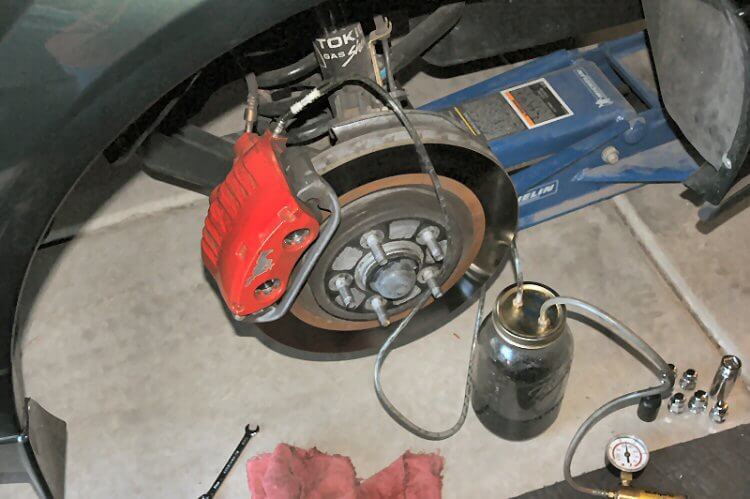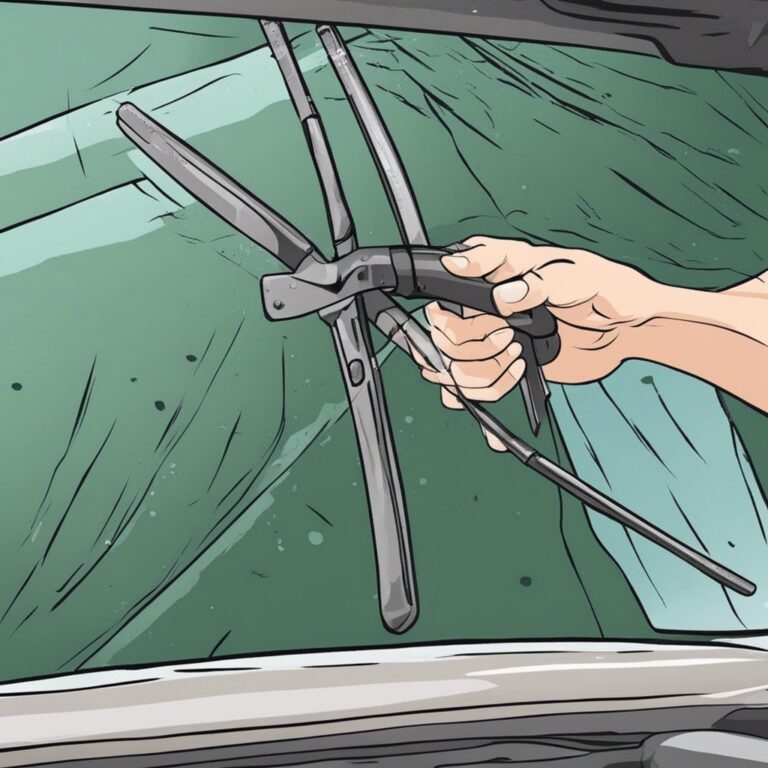How to Flush Break Fluid
To flush brake fluid, locate the brake fluid reservoir and remove old fluid using a syringe or turkey baster. Then fill the reservoir with fresh brake fluid and bleed the brakes at each wheel until the new fluid comes out.
Brake fluid is an essential component of your vehicle’s braking system, ensuring optimal performance and safety. Over time, brake fluid can accumulate moisture and contaminants, leading to decreased brake effectiveness. Regularly flushing the brake fluid helps maintain the braking system’s efficiency and prolong the lifespan of braking components.
By following the proper procedure, you can flush the brake fluid on your own, or seek assistance from a professional mechanic for this important maintenance task.
Why Flushing Brake Fluid Is Important
Properly maintaining your vehicle’s brake system is crucial for your safety on the road. Flushing brake fluid plays a significant role in ensuring your car stops when you need it to by maintaining brake performance and preventing potential damage to the system. It is a simple yet essential maintenance task that should not be overlooked.
Ensuring Brake Performance
Old brake fluid can accumulate moisture, which reduces its effectiveness and causes brake performance issues. By flushing the brake fluid, you remove contaminants that can affect the brake system’s efficiency and responsiveness. Regularly flushing brake fluid helps maintain optimal brake performance and ensures a quick response time when you press the brake pedal.
Preventing Brake System Damage
Over time, brake fluid can break down and lose its ability to function properly, leading to corrosion within the brake system. Flushing the brake fluid prevents the buildup of corrosive materials that can damage brake components such as the master cylinder and calipers. Preventative maintenance through flushing brake fluid can extend the lifespan of your brake system and avoid costly repairs.

Credit: www.redmccombstoyota.com
When To Flush Brake Fluid
When to Flush Brake Fluid
Following Manufacturer’s Recommendations
Following the manufacturer’s recommendations is crucial in determining when to flush the brake fluid. As a general guideline, it is often advisable to check the vehicle’s owner’s manual or the manufacturer’s guidelines for the recommended brake fluid flush interval. This will ensure that the brake fluid is changed at the appropriate time, maintaining the optimum performance of the braking system.
Signs Of Contaminated Brake Fluid
Identifying signs of contaminated brake fluid is essential for determining when it needs to be flushed. Visually inspect the brake fluid for a dark or cloudy appearance, which indicates contamination. Also, keep an eye on brake pedal responsiveness and any unusual noises during braking, as these can be indicators of contaminated brake fluid and may signal the need for a flush.
Materials And Tools Needed
When flushing the brake fluid, you will need a few essential materials and tools to complete the process safely and effectively. Having the right equipment on hand will ensure the job is carried out smoothly. Here are the items you’ll need to flush your brake fluid.
Brake Fluid
Brake fluid is a crucial component for flushing the brake system. It’s essential to use the correct type of brake fluid recommended for your vehicle. Refer to your owner’s manual to determine the specific type required for your car.
Turkey Baster
The turkey baster will be used to extract the old brake fluid from the master cylinder. Ensure the turkey baster is clean and free from any contaminants before using it for this task.
Wrench
A wrench will be necessary to loosen the bleeder screw when bleeding the brake lines. Make sure to use the correct size wrench to avoid damaging the screw.
Clear Tubing
Clear tubing is used in conjunction with the wrench and brake bleeder kit to facilitate the process of bleeding the brake lines. The tubing allows you to see the fluid coming out of the system, ensuring all air bubbles are removed.
Brake Bleeder Kit
The brake bleeder kit is a vital tool for properly flushing the brake fluid. It typically includes a hand pump, reservoir, and various adapters to fit different bleeder screws. This kit simplifies the process of flushing the brake system.

Credit: www.buybrakes.com
Step-by-step Guide To Flushing Brake Fluid
Are you looking to flush the brake fluid in your car? Follow this step-by-step guide for a smooth and effective process.
Preparing The Vehicle
- Ensure the vehicle is parked on a flat surface.
- Gather the necessary tools: brake fluid, wrench, and a container.
- Make sure the engine is off and the car is cooled down.
Removing The Old Brake Fluid
- Lift the car and remove the wheels.
- Locate the brake fluid reservoir and use a wrench to open it.
- Drain the old fluid into a container, disposing of it properly.
Refilling With New Brake Fluid
- Fill the reservoir with the new brake fluid recommended for your vehicle.
- Use a funnel to avoid spillage and overfilling.
- Securely close the reservoir after refilling.
Bleeding The Brake System
- Start with the brake farthest from the master cylinder.
- Attach a clear tube to the bleeder valve to collect old fluid.
- Pump the brake pedal several times until new fluid emerges.
Checking For Proper Brake Fluid Level
- Check the fluid level in the reservoir and add more if necessary.
- Test the brakes to ensure they are responsive and effective.
- Double-check for any leaks or abnormalities in the system.
Tips And Safety Precautions
When it comes to flushing brake fluid, it’s important to prioritize safety and follow the correct procedures. By taking the necessary precautions, you can ensure a smooth and hazard-free process. Here are some essential tips to keep in mind:
Use Protective Gloves And Eyewear
When dealing with brake fluid, it’s crucial to protect your hands and eyes from any potential harm. Before starting the process, make sure to wear protective gloves and eyewear. Brake fluid can be corrosive and cause irritation or burns if it comes into contact with your skin or eyes. By safeguarding yourself, you can minimize any risks and work safely.
Avoid Spilling Brake Fluid
To prevent any accidental spills, always handle brake fluid with caution. Whether you’re filling the reservoir or bleeding the system, ensure that the container or bottle is stable and securely placed to avoid tipping or falling. Moreover, be careful when opening and closing the brake fluid reservoir cap to avoid any splashing or spilling. If any brake fluid is spilled, immediately clean it up with a rag or absorbent material to avoid any slippery surfaces.
Dispose Of Used Brake Fluid Properly
After flushing the brake fluid, it’s important to dispose of the used fluid correctly. Brake fluid is considered hazardous waste and should never be poured down the drain or thrown in the trash. To properly dispose of it, collect the used fluid in a sealed container and take it to the nearest automotive repair shop or recycling center. They will have the necessary facilities to handle and dispose of brake fluid in an environmentally friendly manner.

Credit: www.youtube.com
Frequently Asked Questions For How To Flush Break Fluid
Can I Do A Brake Fluid Flush Myself?
Yes, you can do a brake fluid flush yourself. It’s important to follow these steps properly for optimal results.
Is Brake Fluid Flush Really Necessary?
Yes, brake fluid flush is necessary to prevent brake system failure, maintain performance, and ensure safety.
How Much Does A Brake Fluid Flush Cost?
The cost of a brake fluid flush typically ranges from $70 to $150, depending on the vehicle and location. It’s important to have this service done every 30,000 miles for optimal brake performance and safety. Regular maintenance can prevent costly repairs in the future.
Can I Just Add Brake Fluid Without Flushing?
Adding brake fluid without flushing is okay as a temporary solution. However, it’s crucial to flush the system regularly. Failing to do so can lead to moisture and contaminants building up, causing damage to the braking system. Regular flushing ensures proper functioning and safety.
How Often Should Brake Fluid Be Flushed?
Brake fluid should be flushed every 2 years or 30,000 miles, whichever comes first.
What Are The Signs That Brake Fluid Needs To Be Flushed?
Spongy brake pedal, contaminated fluid, and longer stopping distance are signs that brake fluid needs flushing.
Can I Flush Brake Fluid Myself?
Yes, you can flush brake fluid yourself by following the proper procedure and using the right tools.
Conclusion
Maintaining your brake fluid is crucial for your car’s safety and performance. Regularly flushing it ensures smooth braking. Keep your vehicle running smoothly by following these steps. Stay safe on the road and protect your investment with proper brake fluid maintenance.
Your car will thank you.

